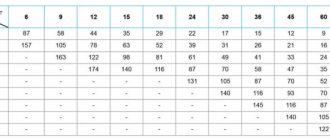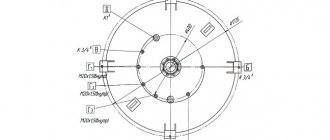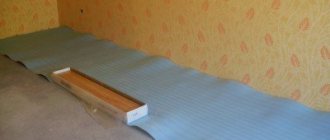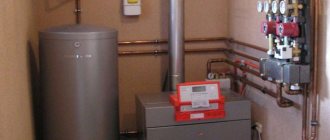What is the principle of saving when metering electricity with a two-tariff meter?
Statistics show that electricity consumption is not evenly distributed over time throughout the day. The rise begins in the morning, the peak occurs in the daytime and the fall occurs in the evening. The graph below shows the distribution of electricity consumption during the day in a particular area of the settlement:
- The first upward trend begins from 7:00 to 9:00 - the beginning of the working day, household electrical appliances are turned on, people gather at enterprises that begin to actively operate.
- From 10:00 to 17:00 the main peak of the daytime load on the power grid is observed with a short drop at lunchtime. This is due to the work of numerous industrial enterprises.
Daily network load graph
- From 17:00 to 21:00 there is a slight increase in electricity consumption due to consumers arriving home and solving economic problems. Lighting and household appliances are turned on.
- From 21:00 to 23:00, the level of electricity consumption drops and becomes consistently low until 7:00 - the majority of the population is asleep.
Taking into account this distribution of electricity consumption over time, energy supply organizations interested in the rational operation of electrical networks have developed a multi-tariff payment system. Manufacturers were ordered a two-tariff electricity meter, where tariffs for consumed electricity depend on the time of its consumption.
The principle of operation of a two-tariff meter or how electricity consumption is calculated
A meter that counts according to two tariffs looks similar to a regular one. It has two display screens. One calculates daily consumption, and the other calculates nighttime consumption. The “day zone” is from 7 a.m. to 11 p.m., and the “night zone” is from 11 p.m. to 7 p.m.
The following tariffs apply in the Moscow region:

Let's calculate whether there will be any benefit from splitting tariffs. The tariff for a regular meter is 5.38 rubles/kWh and the tariff, differentiated day/night: the cost during the day is 6.18 rubles/kWh, at night – 2.29 rubles/kWh. So, if you use two-tariff metering, then during the day you pay 80 kopecks more for one kWh, and at night you save 3 rubles 9 kopecks for one kWh. To equalize consumption, it is necessary that for each kWh used at night, there should be no more than 3.86 kWh of the “day zone”. If the ratio is higher, then there will be no savings; on the contrary, it will be more expensive.
Three-phase or single-phase design
When purchasing, it is important to clarify for which network this electric meter model is intended. The signs are as follows:
The signs are as follows:
- A 1-phase device has two terminals on each side, that is, four in total.
- 3-phase has at least four terminals on each side, that is, at least eight in total (there may be additional ones).
Those who live in city apartments need to purchase a 1-phase meter. But owners of private houses, if they do not know the number of phases, should first calculate the number of wires in the line connected to the house. If there are two of them, the network is 1-phase, if there are four, it is 3-phase.
A 3-phase model can be connected to a single-phase network without any problems, so those who currently have one phase, but plan to switch to a 3-phase power supply in the future, can safely purchase a three-phase meter. But, of course, it is impossible to connect a 1-phase meter to a 3-phase network.
The electric meter cannot be returned or replaced if it does not fit. The fact is that when selling a device, a special mark is placed in the passport - because of this, the product, as they say, cannot be returned, unless, of course, a manufacturing defect has been identified.
Therefore, when purchasing, all parameters and characteristics of the meter must be checked with all possible thoroughness.
In addition to phasing, pay attention to:
- rated current: must exceed the maximum of the input circuit breaker by one step;
- accuracy class.
An important characteristic is the noise level (some models buzz)
The best single-tariff electricity meters
The choice of single-tariff devices is simply huge, but finding good electric meters in all this variety is not so easy. We have tested 40 different models so that you can install the highest quality and most accurate device that will not let you down in operation and will allow you to save a significant part of your family budget.
Energomera CE 101 R5.1 145 M6
If you need a good electricity meter for your apartment, we advise you to take a closer look at the Energomera CE 101 device. The device can be called successful in terms of the combination of price and quality, thanks to which it is incredibly popular among owners of both apartments and private houses.
The model works stably, preventing loss of readings even during light outages. This is especially true if you choose a device for a summer house or garage. The Energomera electric meter is not afraid of low temperatures, which expands the possibilities for choosing where to install it. The device is secured using three screws. According to the seller's warranty, the device will serve you for about 30 years.
Advantages:
- Long warranty;
- Low price;
- Reliable design;
- Large numbers;
- Modest dimensions.
Flaws:
- Lack of digital metering board;
- Poor mounting method.
Mercury 202.5 5-60A/220V class 1.0
The single-tariff meter Mercury 202.5 rightfully takes its place in this rating; a modern device with a classic design meets all customer requirements. Judging by the reviews, the device can operate at low temperatures and high humidity (-45/90%). The device has a technological reserve for the accuracy class, which guarantees the accuracy of the readings. The technology of the device includes a shunt for measuring current, and the pulse output allows the meter to be used both autonomously and in an ASKUE system.
The manufacturer guarantees continuous operation of the device for 30 years. It is also worth noting the modest overall dimensions and low weight. For such a low cost, you will receive a properly working electric meter, which can be installed either on the landing or in an unheated cellar.
Advantages:
- Low cost;
- Mechanical indication;
- High accuracy of readings;
- The device can be installed independently;
- Durability.
Flaws:
Sometimes there are factory defects.
Easy to use, the Mercury 202.5 counter will appeal to those who are looking for a modern device that performs its direct functions. Of course, the device does not support many options, but it is ideal for installation in a country house or garage.
Taypit Neva 103/5 1s0
Speaking about good electric meters, one cannot fail to mention the Typepit Neva 103/5 device. The device has a certificate of conformity, so it will serve you faithfully for the entire period stated by the manufacturer. The meter is equipped with a simple 7-digit reading device; it can be installed in any room due to its large operating temperature range from -40 to +60 C.
Separately, it is worth mentioning the attachment of this electric meter to the surface. Includes reverse stops, LED indicator, shunt and screw terminals. When installing the device, convenient DIN rails are used. Installing the device will take a couple of minutes, and strong latches will ensure secure attachment to the wall.
Advantages:
- Sturdy mounting latch;
- Low cost;
- Long service life;
- Non-separable body;
- Reliable design;
- Accurate readings;
- Small dimensions, light weight.
Flaws:
Inconsistency of display, which can be misleading.
The Taypit Neva 103/5 electric meter has good reviews among consumers and experts. If you do not want to spend a lot of money, and at the same time want to get a high-quality device, it is better to choose this one.
Popular models
Today, three models of two-tariff meters are most in demand on the market - MZIP, Energomera and Mercury. Let's take a closer look at them.
Mercury
Mercury meters are produced by , which produces a wide range of metering devices - from conventional 1-phase devices to more complex 3-phase models.
The products are manufactured at a high technical and scientific level, which makes NPK Incotex one of the best companies today.
Now the company produces other products - cash registers, automated accounting and control systems, various types of screens and displays, POS and other equipment.
Popular multi-tariff meters include the following Mercury models:
- Three-phase - 256 ART, 234 ARM (2), 230 ART, 231 AT, 231 ART Sh.
- Single-phase - 206, 203.2T, 201.8 TLO, 200.
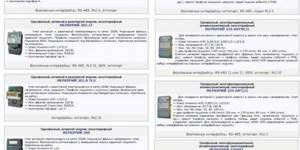
Energy meter
The Energomera company positions itself as the Russian market leader in the production of metering devices. Every year, more than 3 million metering devices are produced at the enterprise's factories. Moreover, over 20 years of operation, more than 30 million devices have been produced.
The company includes 4 factories and 1 institute. In addition to two-tariff meters, the company produces ASKUE systems, low-voltage equipment, metrological and switchboard equipment, devices for electrochemical protection and other equipment.
Popular models of multi-tariff meters include:
- Single-phase - CE 102-R5.1, CE 102M-R5, CE 102-S7, CE 102M-S7, CE 201-S7.
- Three-phase - CE 307-R33, CE 301-R33, CE 307-S31, CE 303-R33, CE 303-S31.
MZEP
At the moment, the Moscow MZEP plant is considered one of the best in the field of manufacturing metering devices. Every month, the plant produces more than 100,000 devices, which are used both in private homes and in large organizations.
The company's products are certified and meet internationally accepted quality standards. Before sale, the plant's two-tariff meters are tested by the metrological service, and their compliance with the requirements is confirmed by certificates.
Popular multi-tariff models of the manufacturer:
- Single-phase - AGAT 2-12, AGAT 2-23M, AGAT 2-23M1, AGAT 2-27M, AGAT 2-42.
- Three-phase - AGAT 3-1.100.2, AGAT 3-1.5.2, AGAT 3-1.50.2, AGAT 3-3.100.5, AGAT 3-3.60.2.
Mercury counters: varieties
First you need to familiarize yourself with all the Mercury meters that have gained popularity in our country. Let us note the fact that the Incotex company, which is a manufacturer of these units, has been a leader in modern markets for quite some time and produces not only electric meters, but also many other electronic equipment.
So, among the best Mercury counters are:
- Mercury 200;
- Mercury 201;
- Mercury 221;
- Mercury 230;
- Mercury 231;
- Mercury 321.
Separately, you should pay attention to the 200 series. Such units are mainly used in single-phase networks, with alternating current in the main circuit
In nominal metering, voltage is coded in volts. In this situation, electricity metering is done according to a single tariff plan.
The 201 series meters are considered to be the most popular. They have become widespread and therefore are currently used as the main installation for monitoring electricity metering not only in private homes, but also in enterprises. Such meters are the most functional; they can be not only single-phase, but also two-phase. As for the design, it is of excellent quality and is protected from any type of hacking.
An electric meter from this manufacturer can be:
Each electric meter requires a separate approach, and it is very important to know how to correctly take readings from them. The meter must be installed by a person from a special service, who will put a seal after installation
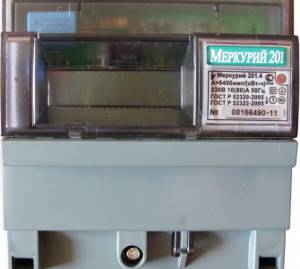
The meter must be installed by a person from a special service, who will put a seal after installation
This category includes several more serious types of counters:
All of them are used depending on the area in which the measurement should take place. The listed types are designed to operate with a rated current of 5A, while the maximum operating mark is 60A.
Reading readings from electronic meters
Currently, devices with several phase options are used. The display shows data reflecting the amount of resource consumed.
There are the following types of metering devices:
- with one tariff. In this case, division into zones is not used, the citizen pays for consumed electricity at a standard tariff;
- There are 2 tariffs. The device separately records the resource consumed at night and during the day. Payments are calculated at different prices;
- with 3 tariffs. Then the counter, in addition to day and night time, records the peak phase.
The phase division method helps to divide the consumed amount of electricity throughout the day. This method allows you to save light and pay less.
The procedure for taking readings from an electronic device
You will need to perform a certain algorithm of actions.
Including:
- press the “Enter” key located on the meter body;
- look at the display, where the values for different phases are displayed. They are called: T1 - energy consumed during the day, T2 - resources used at night, T3 - peak phase;
- copy the data into a notepad so as not to forget;
- transfer information to the resource supply company.
In a situation where a citizen initially used an old-style device and then installed a new device, he needs to take into account the data in the act of putting the device into operation
The document contains initial readings that must be taken into account when submitting data for the first time.
How to take readings from three-phase meters
There are two types of three-phase electricity meters - the old type, which requires transformers, and electronic direct connection (without transformers). If an electronic one is installed, the electricity meter readings must be taken in the same way as described above. Simply write down the values, wait until the necessary information is displayed on the screen, or “scroll” the data to the required page.
Connecting an electric meter in a three-phase network via current transformers
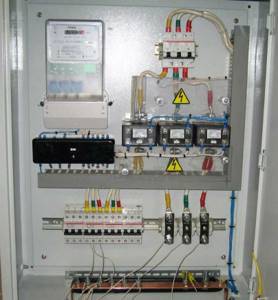
If a large amount of power is allocated or an old-style meter is installed, a transformer is installed on each of the phases. To take readings in this case, you need to know the transformation ratio. The readings taken must be multiplied by this coefficient. The resulting figure will be the actual expense.
But in general, you need to read the contract. The calculation procedure must be prescribed there - in some organizations they write out readings, put down the transformer data or transformation ratio, and the actual calculations are made by the operator himself. So, if you have a 3-phase meter, check the form and procedure for calculations when installing and sealing the metering device and putting it into operation.
How to choose a two-tariff meter
To choose a meter for home use, you need to find out about the availability of additional functions. These include taking measurements of the main parameters at the moment. In modern accounting mechanisms you can find additional memory and a built-in RCD. There is also protection against short circuit in the power line.
When purchasing a device, you need to make sure that this copy is approved by the State Register. Installations and indicators must be in accordance with current tariffs. If this issue causes confusion, you should consult your energy company.
It is not recommended to purchase electric meters from dubious sellers. An organization that sells metering devices must have appropriate documentation that allows it to sell such devices.
How to take readings from a two-tariff device
How to calculate electricity day/night? This question worries many users who are using this device for the first month.
Go to the counter and look at it carefully. A lit checkmark above the tariff name indicates that this tariff is active. The inactive checkmark blinks. When you press “Enter”, data for each tariff is displayed on the screen one by one.
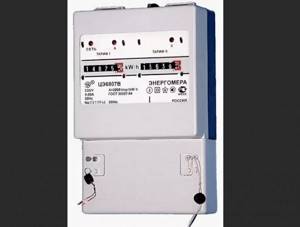
Two-tariff electricity meter: features of devices
With an increase in electricity tariffs in 2021, many owners of apartments and private houses are seeking to reduce the cost of paying utility bills. There are several options to solve this problem. Some resort to installing energy-saving equipment of the latest generation. Others prefer to buy a two-tariff electricity meter, the price of which, although higher than the prices of standard devices, nevertheless allows for savings in subsequent operation.
A two-tariff meter helps you save on electricity bills
Two-tariff electricity meters: at what point does night time switch to day time?
At night, you may notice that working incandescent lamps in the house shine brighter than in the evening. This trend is especially typical for houses in rural areas located far from the transformer substation. In some cases, the differences can be so great that obtaining high-quality electricity is only possible through a voltage stabilizer.
In integrated energy systems, which are typical for apartment buildings, to solve this problem it is enough to buy a two-tariff electricity meter, which is what most of the population does. The use of such devices assumes that 1 kW of electricity will have different costs depending on the time of day.
Two-tariff meter in the distribution panel
In the daytime, the cost of 1 kW charged by a two-tariff device is slightly higher than when using a conventional meter. This period lasts from 7:00 to 23:00. Next, a preferential tariff comes into force, which allows you to significantly save energy costs. Moreover, the cost of 1 kW is several times less. This period lasts from 23:00 to 7:00.
How do two-tariff electricity meters work?
The principle of operation of separate or differential tariffs is very simple. To understand how multi-tariff type devices work, you can imagine several standard meters combined in one device. Each of these units calculates electricity exclusively within its own time interval, after which the next device comes into operation. In this case, readings for each device are taken separately, calculated taking into account tariffs, and the results are summarized.
Of course, it is impossible to organize the timely launch of several metering devices using a mechanical meter. For this reason, multi-tariff devices, including two-tariff designs, have only an electronic control option. These units are equipped with a display where all the information is located.
Multi-tariff meters have a built-in clock
Multi-tariff meters have a built-in clock for convenient switching of the device between different tariff zones, as well as a memory that allows you to save this data. Most often, each zone is marked with the letter “T” with a certain numerical index. The “T” marking without a numerical index displays the total amount of electricity consumed in kilowatts. This value would be displayed by the standard counter if one was installed.
Advantages and disadvantages of installing two-tariff meters
Why is it profitable to buy a two-tariff type electric meter:
- Significant savings in money - the cost of installing an electric meter and purchasing it pays off within a year.
- Unloading power plants - energy supply companies will resort to repairing equipment less often, and its further operation in this mode will save fuel spent on creating electricity.
- Improving the environmental situation - the amount of emissions from fuel combustion into the atmosphere is reduced due to the absence of overloads.
Most often, electricity consumers rarely ask questions about the environment and rationalization of electricity supplies, so the main advantage of two-tariff devices can be called their cost-effectiveness.
Many people install 2-tariff meters in their apartments
The operation of multi-tariff devices also has its disadvantages:
Not in all regions of the country the difference between day and night tariffs is large. The cost of 1 kW of energy at night is 15% less than during the day. After installing an electricity meter, the cost of energy consumption will decrease only if the household appliances are used correctly. For example, it is advisable to use the dishwasher or washing machine only after 23:00.
Readings of electronic electricity meters
Electronic electricity meters do not have a mechanical display with “jumping” numbers, but an electronic one. It can display not only numbers showing how many kilowatts were spent, but also the date, operating time of the meter, and some other data. In most electronic light meters, these data replace each other after a few seconds. If the meter is multi-zone, readings for each zone are displayed sequentially (T1, T2, T3, T4).
To take readings from an electronic electricity meter, you can wait until the necessary information appears and write it off. The second option is to press the “enter” button. You may have to click more than once until the required information appears. It can be distinguished by the icons displayed on the screen. Usually this is T1, T2, T3, T4 or the word TOTAL.
For example, in the photo below, on the screen in the upper left corner we see the T1 icon and a little further on there are larger numbers - 72.69. If you look closely, there are units of measurement behind them - kWh. This is the consumed electricity in the first zone T1 (daily tariff).
Example of electronic meter readings
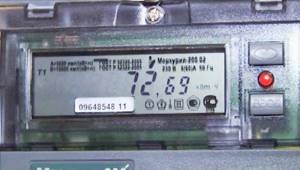
After the necessary data is displayed, they are recorded on the receipt and then calculations are carried out (described above). If the data simply needs to be transferred to the subscriber service, they can be written down on a piece of paper.
Be careful! Here, too, you only need to rewrite the whole part, not taking into account the decimal places. For example, in this case (in the photo above) it is necessary to transmit or carry out calculations only with the number 72 without a “tail”.
The Energomera looks a little different on the electronic meter
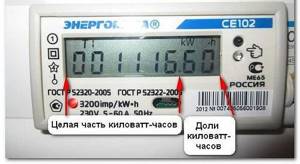
How to take readings from the Mercury 200 meter
There are single-tariff Mercury meters (in the specification they are designated as 200.00), and multi-tariff ones (with numbers after the dot other than zeros, for example Mercury 200 01, there may also be 02 or 03). They differ in the number of zones, as well as the presence/absence of a control panel.
Regardless of the model, the readings are taken the same way. You just have to press the “enter” button a different number of times or wait for more numbers to appear.
Mercury 200 electricity meters alternately show time, date, then tariffs by zone. First, the time is displayed in the usual rate - hours, minutes, seconds are shown a little higher. Then after a few seconds the date appears on the screen. It is also displayed in the standard format: day, month, year.
Time and date
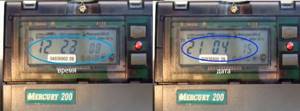
After this, the display of tariffs begins. The name of the tariff appears in the upper left corner: T1, T2, T3 or T4. Their number depends on the model you have installed. They are all highlighted one by one. At this stage they can be written down (the whole part, without decimal places).
Readings of a two-tariff meter Mercury 200

After all tariffs, the checksum of all tariffs appears. Then the cycle repeats - time, date, tariffs, total value, etc.
The last one to appear is the sum of all tariff readings

The numbers on the screen change every 5-10 seconds, depending on the settings. It’s quite possible to have time to write it down. But if you didn’t have time, you can switch to tariffs manually. To do this, you must press the “enter” button at any time. In the photo it is under the red LED. Press the button (press/release) until the value you require appears. To switch to the next one, click again. It's not difficult at all.
It will be a little more difficult with the calculations, since you will have to calculate the number of kilowatts consumed for each zone. This is where all the difficulties will end. You now know how to take readings from a multi-tariff electricity meter. All other models of Mercury meters are not much different in this regard. Even their buttons look the same and are located in the same place.
Energy meters
Taking readings from the Energy Meter day-night electricity meter (two-tariff or multi-tariff) occurs in exactly the same way. The difference is that the button on these electricity meters is called “PRSM” (view). There may be two or three buttons, depending on the modification.
Electricity meter Energomera CE301

When you click on this button, numbers appear showing how many kilowatts were “increased” for each tariff zone. There are no more differences.
Take readings from the Micron electricity meter
In Mikron multi-tariff electronic electricity meters, there is only one button on the case, and you need to press it to display the required readings on the screen. Only in this case, you need to wait until “checkmarks” appear on the display above the letters “T1” and “R+” (see photo). This will be the reading for the first tariff.
How to take readings from the Micron electric meter model SEB-1TM.02M
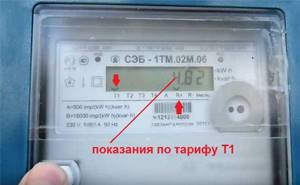
Then click on the same button until the checkmarks appear above T2 and R+, if there are more zones, click further. This is how readings are taken from this day/night meter.
Saiman counters
Now in many regions they replace old induction meters with electronic ones free of charge and most often install devices from Saivan. These are very simple devices; they do not have buttons that can be used to forcefully “scroll through” the readings. You just have to wait until the required value is displayed. That is, in this case, take readings from the electricity meter - just wait until the required value (TOTAL) is displayed and write it down on the receipt (or transfer it to the appropriate service).
To make it easier to navigate, here is the order in which the data is displayed in this electric meter:
- date of;
- time;
- meter number;
- gear ratio (1600);
- TOTAL - readings of a single-tariff meter or are displayed sequentially T1, T2, TOTAL for day/night type meters (two-tariff).
It is necessary to record the TOTAL or T1 and T2 readings and also the general TOTAL readings on the receipt. Let us remind you once again that you only need to write down the whole part, without taking into account the numbers after the decimal point. You can watch the same information in video format.
Connecting two-tariff metering devices
What a two-tariff meter is is well known to residents of new buildings, because almost all newly commissioned houses are equipped with such multi-tariff electricity meters.
If not, consumers, when replacing the electric meter again, can write a statement to Gosenergonadzor and the energy distribution company in their region about their desire to change the metering equipment. The connection must be completed by specialists from the energy organization within 24 hours. As a rule, many energy companies perform the entire range of work (at the consumer’s request): they purchase two-tariff meters, install them, configure them and provide subsequent warranty service.
Upon request, specialists from Gosenergonadzor will connect a two-tariff meter
However, all these operations can be carried out on their own if the homeowner has an idea of how to connect electrical equipment. To do this, you must first thoroughly study the instructions and circuit diagram for switching on the meter, which are included with the equipment set by its manufacturers. First of all, you need to take care of safety, for which you turn off the switch or traffic jams. If the input cable is supplied directly to the meter, the entire line must be de-energized. When installing the metering device, it is necessary to observe the correct order of contacts, taking into account the requirements of the Electrical Installation Rules.
All work is divided into the following stages:
- removal of the previous counter;
- installation of a new two-tariff unit;
- testing the software of a new device and programming it in accordance with existing tariff plans;
- setting up and checking network connection;
- sealing the device.
Important! In the future, in order to avoid fines, it is very important to maintain the integrity of the seal.
How to keep track of electric meter readings
There are two types of multi-tariff meters:
- Conventional: readings are taken in the same way as from a simple mechanical counter, that is, visually. The only difference is that the display is electronic and not roller, as in an induction device. The device will alternately show the number of kilowatt-hours consumed during the day or at night (for a two-tariff scheme), after which this data will need to be multiplied by the corresponding cost.
- With automated reading function: such devices can send data via wires or via radio frequency signals to the payment center computer, if one is organized by the supplier company.
If a company does not have the ability to remove data remotely, there is no point in overpaying for this function, since in itself it will not give the user anything.
Operation
All multi-tariff meters (in this case, two-tariff meters are also meant) are electronic and contain a microcircuit inside. Classic counters, called mechanical or induction, cannot keep separate records.
Before use, a multi-tariff meter must be programmed, that is, its internal clock must be set and time intervals must be set. This operation must be performed by an Energosbyt employee. After its completion, the device is sealed.
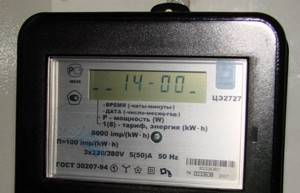
Two-tariff metering device
If reprogramming is carried out not because of innovations on the part of the supplier company, but, for example, in order to switch to a different accounting scheme (at the user’s request), then you will have to pay from 500 to 700 rubles for this service. When switching from winter to summer time and vice versa (cancelled in Russia), such meters also need to be reprogrammed.
Calculation of savings in houses with installed electric stoves
Residents of high-rise buildings do not have gas supply, since the pressure in gas pipes can only reach 10 floors. According to the plan, apartments in such houses are equipped exclusively with electric stoves.

In houses equipped with stationary electric stoves and electric heating installations, the electricity tariff is significantly lower.
Before leaving a single-tariff meter or installing a two-tariff meter, you need to understand whether this is beneficial in terms of electrifying the entire house, take this fact into account and carry out the calculation.
As an example for the calculation, we took the cost of the tariff rate for residents living in houses with installed stationary electric stoves and electric heating installations for the first half of 2021 in the Lipetsk region.
Single-rate tariff - 2.57 rubles. per kW/h.
Two-zone tariff:
- day - 2.96 rub. per kW/h;
- night — 1.54 rub. per kW/h.
Estimated consumption in winter is 300 kW per month. Single-rate tariff - 2.57 per kW/h. Thus, with a single-tariff meter, the consumer will pay for the services of energy sales companies: 300 × 2.57 = 771.00 rubles.
Consumption in winter is also 300 kW per month, but 100 kW is during the day and 200 kW at night. The volume of kilowatts is calculated at a tariff differentiated between two zones. Day – 100×2.96=296.00 rub., night – 200×1.54=308.00 rub. The total amount for a two-tariff meter per month will be 604.00 rubles.
Calculation of the difference and determination of savings: 771.00−604.00=167.00 rub. per month, and per year - 167.00 × 12 = 2004.00 rubles.
The savings are slightly lower than in houses with gasification, but over time, for example, over a year it still turns out to be quite a significant amount. In houses with built-in electric stoves, the consumer himself chooses the optimal metering tariff for him and whether the electric meter needs to be replaced.
The best multi-tariff electricity meters
One of the best budget options for a multi-tariff electricity meter. The feasibility of installing a meter of this type depends on the presence of electrical consumers in the house or apartment, whose active operation can be combined with the cheapest tariff. And without creating any special inconvenience in everyday life. Examples include underfloor heating, an electric boiler or a boiler for heating water. Energy supply organizations also favor the Mercury 200.02 model, since it has a built-in PLC modem and makes it easy to integrate this meter into the ASKUE system. The device can store information about monthly consumption, which can be useful in case of controversial situations.
- affordable price;
- is able to keep records at 4 tariffs;
- built-in PLC modem and CAN bus;
- memory of monthly readings.
- quite large dimensions;
- useless if the main energy consumption occurs during the day.
I try not to use powerful electrical appliances during the peak zone. On average, the savings are about 300 rubles per month, so for me a multi-tariff electric meter is the best option. A little more and I’ll recoup the cost of purchasing it.
Energy meter CE102 S7
1,600 (for modification CE102 S7 145 OKPSVZ)
About this counter it would be enough to say that at one time it received the award “One Hundred Best Products of Russia”
The model is really interesting and, no less important, universal. Its indicator displays a lot of necessary and simply useful information
Moreover, the duration of the display cycle is adjustable. The device remembers data for the last year and is capable of storing it during a power outage for at least thirty years. It integrates perfectly with a large number of automated accounting systems, for which many management and supply companies love it. You just need to consult before purchasing what interface the CE102 S7 meter must have, since it is available in several modifications.
- factory warranty 5 years;
- extended temperature range;
- 7 modifications with different sets of interfaces and additional options;
- There is a modification with built-in load control.
The quality of workmanship greatly depends on the components used.
Having an electric boiler installed in the cottage, I fully justified the costs of purchasing and installing this multi-tariff meter in eight months.
Economic justification of costs
The simplest example would be even an ordinary apartment, in which the following devices are present:
- water heater;
- electric stove;
- washing machine;
- multicooker;
- bread machine, etc.
Most appliances can be used during periods when the cost of electricity is lower. A water heater with a volume of 50-70 liters, heated at night and used sparingly, is quite sufficient for daytime needs.
Many washing machine models have a delayed start, which allows you to start washing at night.
Less powerful devices can be used similarly. As a result, every kilowatt of energy consumed will be cheaper. During the daytime, only low-power devices are used.
Almost half of all consumption can be transferred to the night. With a 50% discount from the base tariff, the amount for electricity will be reduced by a quarter. Therefore, the transition to a modern two-tariff electricity meter is recommended. Depending on the level of consumption, it will fully pay for itself within 1-2 years.
Watch the video, which discusses the features of using two-tariff electricity meters:
How do you pay?
To make a payment you will need a receipt with the accrued amount for the light, a calculator and a pen.
The algorithm of actions is as follows:
- We take readings from a two-tariff meter for the day and night shifts.
- We take the old receipt, according to which payment was made for the last month, and subtract the previous parameters in the section “On the day of payment” from the figure of the new readings. We multiply the resulting number by the tariff that is valid in the city (region) of residence.
- We subtract from the number of “night” readings the data that is recorded in the old receipt in the column “On the day of payment”. We multiply the resulting number by the tariff that applies to the night zone.
- Sum up the received figures for the day and night, after which we make a payment taking into account the result obtained at the nearest bank branch or in another way (for example, at a Russian Post office).
When paying through a banking institution, the money arrives within one to three days, and the transfer by mail takes place within 1 to 2 weeks.
If a three-tariff meter is installed on an apartment or house, calculations are made for three zones separately - for daytime, peak and night tariffs. Next, the resulting figures are multiplied by the current tariff and added up according to the principle discussed above.
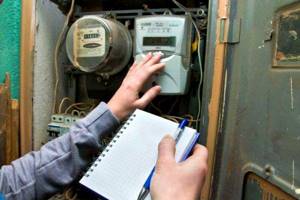
If benefits are provided, the calculation is done as follows. First, we calculate the amount of the discount from the total amount payable and subtract the result from the total amount. After this, the payment is made.
In a situation where the check arrives from a clearing center, it is recommended to make payment according to the indicators from the receipt. As a rule, it indicates the average parameters for the previous year.
At the end of the calendar year, a recalculation occurs, and the overpayment will go to the next year. If any amount is missing, you will have to pay extra.

Two-tariff electricity meter - pros, cons and features
Many people are interested in reducing their electricity bills.
This is not surprising, because today more and more complex equipment with high power is appearing, which consumes a significant amount of electrical energy, and sales companies are increasing energy tariffs every year.
As a result, electricity costs increase and cause significant damage to the family budget. Therefore, to save money, consumers install two-tariff meters in apartments and residential buildings.
Advantages of a two-tariff electricity meter
- Saving the family budget. The tariff for electricity at night is 1.5-2 times lower than during the day.
- High payback. Thanks to monthly electrical energy savings of 20-30%, the cost of purchasing a two-tariff meter and replacing it will pay off within a year.
- Help for electrical substations. Due to the increased load at night, transformers and auxiliary equipment operate more evenly throughout the day. In this regard, the wear of the substation is reduced and the operating time of electrical installations is increased.
- Reducing the emission of harmful substances into the atmosphere. Thanks to more uniform operation of electrical equipment during the day, substations consume less fuel and emit a small amount of harmful substances.
Disadvantages of a two-tariff electric meter
- It is necessary to change the daily routine. When installing a two-tariff meter, it is more efficient to use it at night. If you are a night owl, this will not be an obstacle for you, but if you are a morning person, you will have to adapt. Therefore, household appliances that consume the largest amount of energy resources should be used from 23:00 to 7:00, otherwise there will be no benefit from a two-tariff meter. Electrical appliances that can be used at night include: dishwasher, heater, air conditioner, washing machine, chargers.
- Tariff difference. Before installing a two-tariff meter, you need to find out the cost of T1 and T2 tariffs in your city. As practice shows, in each subject of Russia, the price of energy resources is different.
For example, if the night tariff is only 10-20% cheaper than the day tariff, switching to a two-tariff calculation is not beneficial to the consumer. Moreover, it will not pay for itself even over the entire period of its service.
How to calculate the benefit of a two-tariff electricity meter?
To understand whether it is worth installing a two-tariff metering device or not, it is enough to do a number of actions:
- Find out the price of 1 kW using single-tariff and two-tariff calculations.
- Calculate electricity consumption at night.
Then you need to substitute the resulting values into the following formula:
Mon – night consumption.
Td, T1, Tn – the cost of daytime, round-the-clock and night tariffs.
If after calculations the value is 20%, then in order for costs before and after the transition to two-tariff calculation to remain at the same level, it is necessary to increase night-time consumption relative to daytime consumption by 20%. In this case, the use of a two-tariff meter will become profitable and save your budget.
How to choose a two-tariff electric meter?
Before purchasing this meter, you need to determine the exact number of phases in your network. In most cases, in residential buildings there is one phase. This value can be determined by the voltage in the circuit, which is 220 Volts. With three phases, the voltage will be 380 Volts.
You need to know that installing a single-phase two-tariff meter in a network with three phases is impossible, but installing a three-phase meter is possible on a line with one phase. Therefore, if you do not have an electrical engineering education and cannot determine the exact number of phases in your home, contact a specialist.
Conclusion
Switching to two-tariff payment is a good way to save your budget, but not in all cases.
Before installation, you need to find out from the sales company the cost of day and night tariffs separately and calculate the economic feasibility of replacing the existing single-tariff meter.
If the payback period for installing a metering device is less than 3 years, then the use of a two-tariff plan is a rational solution in the fight against spending money on energy resources.
We save legally
It is worth abandoning the dubious idea of saving on electricity using neodymium magnets and suspicious devices that allegedly deceive the meter. How to reduce the readings of an electronic electricity meter? This is done legally - the alternative is on the surface. The two-tariff system itself will reduce costs.
How it works
There are one-, two- and multi-tariff meters and payment systems. The latter take into account, in addition to daytime and nighttime electricity consumption, peak hours (7.00–10.00; 17.00–21.00).
The night tariff for electricity in the Russian Federation is from 2300 to 700. During the day they pay at a standard price, at night at a cheaper price. A single-tariff meter records all electricity used and records it in the overall balance. Daytime and nighttime consumption cannot be seen. A two-tariff meter distributes used electricity to 2 different balances.
Let's look at what it looks like in Moscow for an apartment with an electric stove:
| Regular rate | 2 tariffs (“day”, “night”) | |
| Day | 5 kWh X 4.04 rub. = 20.2 rub. (per day) | 5 kWh X 4.65 rub. = 23.25 rub. (per day) |
| Night | 5 kWh X 4.04 rub. = 20.2 rub. (per day) | 5 kWh X 1.26 rub. = 6.30 rub. (per day) |
| Result: 20.2X2=40.4 rubles. (for 1 day). 40.4 rub. X 30 days = 1,212 rub. (per month) | Result: 23.25+6.39=29.55 rub. (for 1 day). RUB 29.55 X 30 days = 886.5 rub. (per month) |
If a single-tariff meter “counts” 1,212 rubles for electricity. per month, then a two-tariff with the same consumption will reduce the amount to 886.5 rubles. Savings - 325.5 rubles.
Why it's useful
- People pay less for electricity. To save more, set household appliances that consume a lot of electricity to the “night” or “late evening - early morning” mode. This is a washing machine, a boiler, a dishwasher, a multicooker, and a “warm floor.”
- The state sells electricity, which is oversupplied at night. The stations that produce it do not stand idle, but work.
Who benefits from a multi-tariff meter?
promises savings of up to 50%. But in practice, the counter will not bring profit to everyone. The benefit can be insignificant, and due to the start-up costs (price, installation of the device), it can take a long time to recoup the investment. Users say that it will pay for itself in 2.5 years.
When is a day-night electric meter profitable:
- The room is heated with electricity.
- They use pumps, an electric boiler, and climate control.
- There is a boiler.
- Consumes a lot of electricity, 30-50% at night.
- In standard apartments with low power consumption, without “gluttonous” appliances, it is not justified. The savings are small and will not pay off soon.



